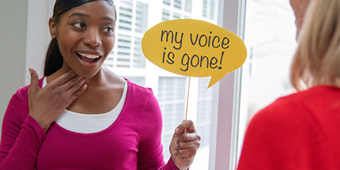Is Your Balance Out Of Whack? Try Vestibular Rehab

Find a Vestibular Physical Therapist
Online scheduling is available for your initial evaluation with a Premier Health Vestibular Physical Therapist.
Your inner ear does more than just allow you to hear…it works in harmony with your eyes and muscles to help you stand steady on your feet. But like any other part of the body, the inner ear can have problems. An infection, disorder, injury, or other problems can cause vertigo and dizziness, creating risk for falls and injuries.
While some inner ear problems are simply annoyances that pass quickly, others can create lasting damage and can severely hamper your quality of life. Fortunately, a type of physical therapy known as vestibular rehabilitation can help patients learn to live with, and in some cases, overcome, a life that is lived off-balance.
What Do Our Ears Have To Do With Balance?
Your ability to stay balanced depends on your eyes, your muscles and joints, and your vestibular organs (the inner ear structures). All three areas send signals to your brain and work together to guide you as you walk, stand, and otherwise move through your life.
“The vestibular system is your internal reference that detects movement of your head,” explains Jesse Ehrnschwender, PT, MPT, AIB-VR/CON, a Premier Health physical therapist. “There are also external references, which are primarily what you can see (your vision) and your feeling of the environment around you, like feeling the floor with your feet while you are standing.
“When things are working well, your external and internal references are all in agreement and you feel balanced.”
However, when your internal and external sensors are not in agreement (like when you’re sitting still in a car, but that car is traveling on a hilly, winding road), they send conflicting information to the brain, and vertigo or dizziness is the result.
What Causes Balance Problems?
The dizziness that comes from a spin on a Tilt-a-Whirl or a winding mountain road is usually harmless and temporary. But sometimes an illness or damage to the inner ear can bring more lasting and harmful problems.
Some causes of balance issues include:
- Benign paroxysmal positional vertigo, or BPPV. BPPV is caused when calcium crystals move into the wrong location in the inner ear, sometimes due to a head or neck injury. In other cases, the cause is not known. This is usually a harmless condition that causes dizziness or a spinning sensation when you move suddenly or change positions.
- Meniere’s disease. This occurs when fluid in the inner ear increases and causes swelling. It can cause severe dizziness, and also lead to ringing in the ears (tinnitus) and possible long-term hearing loss.
- Labyrinthitis. This is believed to be caused by a viral infection of the inner ear, resulting in dizziness, a spinning feeling and balance problems.
- Vestibular neuritis. This is inflammation of a nerve in the inner ear.
- Head and neck injuries (like concussion)
- Strokes or tumors affecting the brain
What Is Vestibular Rehabilitation?
Vestibular Rehabiliation is conducted by a specially trained physical therapist, with the goal of improving balance and reducing dizziness-related problems, explains Ehrenschwender. Therapy is individualized according to the patient’s diagnosis and the severity of the problem.
“With vestibular rehabilitation, we’re re-training the brain to process our balance more accurately, or focus on improving the balance information our brain receives in the first place,” Ehrnschwender says. “Basically, we’re helping the brain do its job, or do it better.”
“With vestibular rehabilitation, we’re re-training the brain to process our balance more accurately, or focus on improving the balance information our brain receives in the first place."
How Does It Work?

In the case of BPPV (a relatively common problem), the therapist will help guide the patient’s head and neck into various positions to try to move the calcium crystals. “It’s like dumping sand out of your shoe,” says Ehrnschwender. “We’re trying to move the crystals out of the wrong part of the ear.” It’s a safe, effective and evidence-based therapy that generally only requires a few sessions.
For more moderate-to-severe diagnoses (like labyrinthitis, Meniere’s disease or concussions), vestibular rehabilitation uses exercises and activity to alleviate the feeling of imbalance, or to help the brain learn to use other senses to make up for the problems with the inner ear.
One technique physical therapists use to help patients is habituation. With habituation, the therapist puts the patient through a series of exercises that gently “provoke” the brain into experiencing dizziness or vertigo. According to the Vestibular Disorders Association (VeDA), these exercises are based on the rationale that by slightly triggering mild dizziness or vertigo, the patient’s brain will become used to the sensation, and eventually stop responding to it.
Another therapy technique is substitution, in which the patient learns new ways of doing things (for instance, in how they use their eyes) in order to reduce dependence on old tendencies that continue to cause balance problems.
“We’re training the brain to process movement differently,” explains Ehrnschwender. “It’s like flying a jumbo jet that suddenly loses an engine. The pilot can still fly the plane on one less engine, but he needs to do a few things differently and learn how to accommodate the change.”
There are some cases of dizziness that cannot be overcome with vestibular rehabilitation, Ehrnschwender says. For example, dizziness or balance issues that are the result of brain problems might not benefit from this form of therapy.
How Long Does Vestibular Rehab Take?
Common problems, like BPPV, only require a small number of sessions. In moderate situations, like vestibular neuritis, labyrinthitis or Meniere’s disease, it may take several weeks or even months to see gradual improvement.
How Do I Know If I Need Vestibular Rehab, And Where Do I Get It?
It’s always appropriate to see your physician first if you are experiencing problems with balance, dizziness and/or vertigo. However, often it’s OK to see a physical therapist first, if your insurance allows it, because they’re trained to refer you to a physician when indicated. Together, your physician and physical therapist can help determine the root cause of your problem. This is important to know because if the root cause is not inner-ear related, you might require a different kind of treatment and/or therapy.
Find a Vestibular Physical Therapist
Online scheduling is available for your initial evaluation with a Premier Health Vestibular Physical Therapist.
Source: Vestibular Disorders Association; Jesse Ehrnschwender, PT, MPT, AIB-VR/CON, Atrium Medical Center, Premier Health





